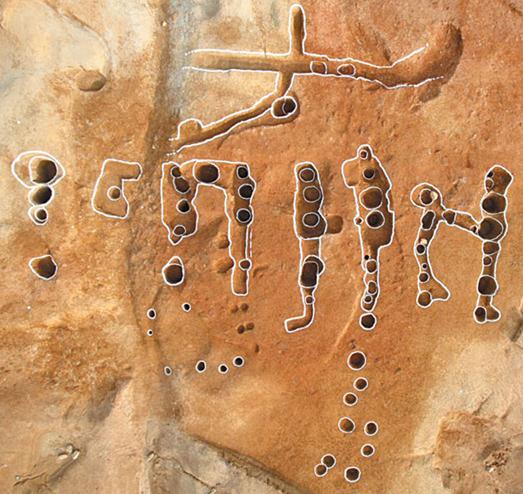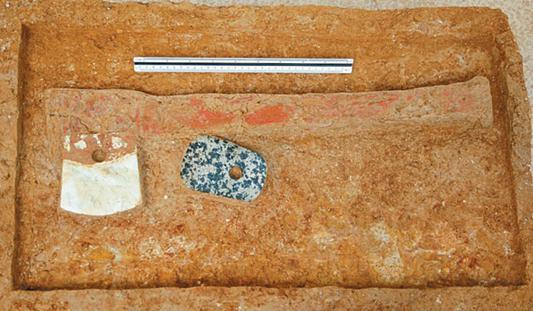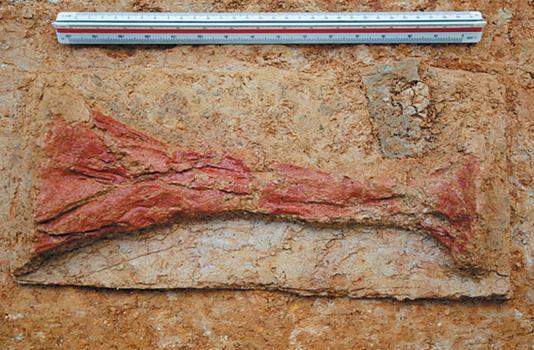Chinese Institute of Archaeology
Source - http://www.kaogu.cn/en/detail.asp?ProductID=4299
The Xiaoqinglong site is located in the south of Tonglu town, Zhejiang, and is about 100km southwest away from Hangzhou city. The site sits on a southeast-northwest ridge in the hilly area of the middle reaches of Qiantangjiang River. From September 2011 to September 2012, the Archaeology Institute of Zhejiang Province and the Tonglu Museum jointly carried out an about 3000 square meter excavation at the site and found 44 tombs, 3 residential buildings, 2 ditches, 28 ash pits, 1 fire pit and more than 200 pieces of artifacts, including pottery, stone tools, jades, lacquers and so on.
The 44 tombs dating to the Liangzhu Culture at the Xiaoqinglong site were distributed in the south and north district. There were 10 tombs in the south district and 34 tombs in the north district. The cemetery in the north district could be roughly divided into east and west part by the ridge line. There were 11 tombs in the east area and 23 tombs in the west area. The layout in the west area was designed carefully. The tombs in higher ranking were all in east-west direction and were distributed in rows. Among them, the tombs, M6-M10-M7-M33-M30-M21, distributing along a central axis, had the highest ranking. These six tombs all were buried with jade yue钺 halberd, jade bi璧 disk and lacquer gu 觚vessel etc. In terms of the tomb scale, the quantity and variety of the grave goods, the ranking of the tombs in the west area of the north district was obviously higher than that in the east area.

According to the direction of the tombs, the tombs dating to the Liangzhu Culture at the Xiaoqinglong site could be divided into two sorts: east-west (around 60︒) and south-north (150︒) direction. Most of the tombs’ bottoms were repaired and hard and smooth. The majority of the tombs had coffins, which mostly had low-lying bottom and few had flat bottom. The grave goods were 0-20 pieces and mostly were jade and stone. These grave goods were regularly laid out. The jade beads or tubes mostly were placed near the head or upper body, while jade bi disk or stone (jade) yue halberd mostly were arranged in the middle of the tomb. Yue halberds were mainly placed in the right hand side and its edge faced inwards. The pottery, stone adzes and stone arrow heads relatively gathered at the feet end. The pottery was generally a double-nose bottle. The high-ranking tombs were generally buried with jade yue halberd or lacquer gu vessel which was usually placed outside the lower part of the right leg and whose mouth faced to the same direction as the tomb owner’s head.
There were 10 pieces of jade yue halberds unearthed from the tombs at the Xiaoqinglong site, and M6:2 is the biggest one among those unearthed jade yue halberds in Zhejiang so far. Moreover, M10:2 jade yue halberd was preserved well and had a lacquered handle which had black pattern on the two ends. In addition, there were lacquer artifacts and lacquered coffins in the high ranking tombs, for example, there were 5 pieces of lacquered gu vessels found and some lacquers which could not be distinguished what they used to be. In the hilly area in the southwest Zhejiang, there were rich jade and stone resource and lacquer material. In addition, there were special workshops for jade and stone production back to the Majiabang Culture and the Songze Culture. Therefore, the jade, stone, lacquer and wooden handcraft industries in this area should be paid more attention.

There were 3 residential buildings cleared at the Xiaoqinglong site and they all were located in the south part of the north area of the cemetery. F1 was a platoon building with multi-room. It consisted of at least four square rooms which were roughly arranged by rows in southwest-northeast direction and were 17 meters long in all. Each room was 1.5-1.8 meters wide and 3-3.5 meters long. Their doors were all faced northwards. F1 was located on the high part of the hill edge. Its upper part was overlaid by East Zhou cultural layer and was destroyed in some degree. Indoor there was not activity surface and other daily facilities found. In front of F1, there were two pairs of postholes found and there were two ditches at the back of F1, which were possibly related to F1.
By digging grooves and erecting posts, the grooves at the back of the building were extended into oblong deep pits. The posts were thick which should be used for load-bearing. There were 43 postholes found in the grooves and the diameter of the posthole was usually about 50cm. At the base of the postholes, there were generally filled stones which consolidated the posts.
Due to the narrow rooms of F1, there were not any daily facilities or wall construction member, such as burned earth. While it is still possible for F1 to be pile-dwelling, but it needs to further consider if this building was used for living.
Only a few potteries were unearthed from the tombs at the Xiaoqinglong site. Among them, the majority were double-nose bottles whose shapes were in consecutive sequence and which are the important artifacts for distinguishing the relative chronology of the site. Compared with the surrounding sites, it can be known that the Xiaoqinglong site was mainly dated to from the late phase of early Liangzhu culture to the early phase of late Liangzhu Culture. The pottery unearthed from H30 had the characteristics of those in the middle Liangzhu Culture. It matched to the chronology of the tombs.
While the prehistoric sites in the upper reaches of the Qiantangjiang River had the same features as the Liangzhu Culture in Tai Lake area, they had the different local characteristics too. So did the Xiaoqinglong site. The characteristics were: 1. the settlement was constructed on a higher terrain land; 2. the tombs were mostly in east-west direction; 3. the grave goods were a few but mostly were jade and stone artifacts with few pottery. Generally each tomb was only buried with one double-nose bottle or no pottery was buried in tomb. These characteristics were different from those of the Liangzhu Culture in the east plain area, such as the tombs put on artificial earth terrace and in south-north direction, ding 鼎tripod, dou豆plate, bottle being the major pottery assemblage. 4. it was popular that stone arrow heads were buried in tombs and stone arrow heads and net weights were often found in cultural layers, showing that hunting and fishing economy played an important role in the life of that time.

The Xiaoqinglong site, as a representative of the Liangzhu Culture in hilly area, is an important type of the Liangzhu Culture, so it could be called “hilly type of the Liangzhu Culture”.
The Xiaoqinglong site has a high ranking and has rich remains. From the constitution of the grave goods, jade, stone, lacquer and wooden craft played important role in the economic life of that time. It is the first time to find the multi-room platoon building in the Liangzhu Culture. The excavation at the Xiaoqinglong site is a significant breakthrough in exploring the Liangzhu Culture in southwest of Zhejiang, and further extends the spatial structure in the Liangzhu Culture study. It supplied fresh and precious material for understanding the archaeological culture, the technology of craft, the settlement patterns in the hilly area of the upper reaches of the Qiantangjiang River and the relationship between the prehistoric cultures in this area and those in the east plain area and even broader surrounding area. (Translator: Zhai Shaodong)